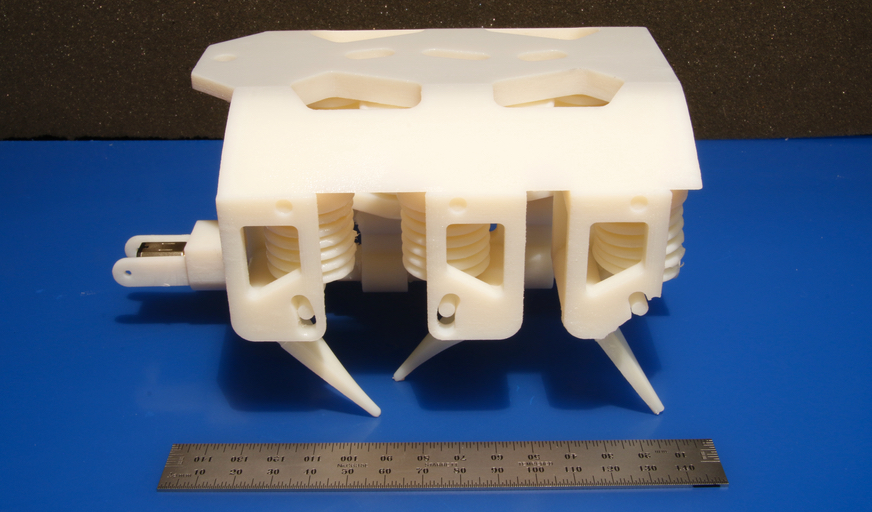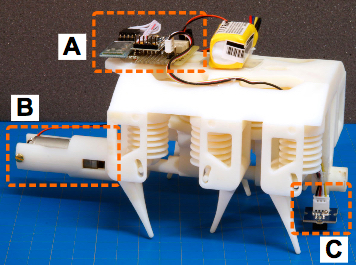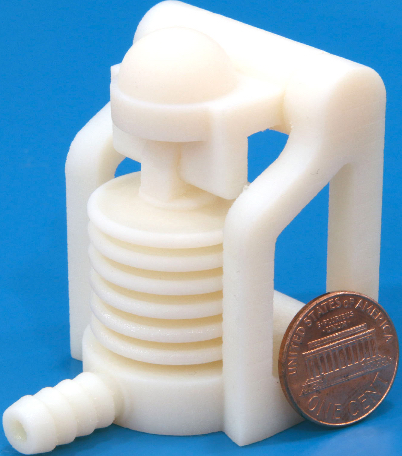MIT AI Lab 3D-prints first mobile robot made of solids and liquids
April 7, 2016

This 3D-printed hexapod robot moves via a single motor that spins a crankshaft that pumps fluid to the robot’s legs. Every component except the motor, battery, and added electronics is printed in a single step, no assembly required. (credit: R. MacCurdy/MIT CSAIL)
Ever want to just push a button and print out a hydraulically-powered robot that can immediately get to work for you?
MIT’s Computer Science and Artificial Intelligence Laboratory (CSAIL) researchers have designed a system that does just that: 3D-prints moving robots with solid and liquid materials in a single step and on a commercially available 3D printer. No assembly required.
“All you have to do is stick in a battery and motor, and you have a robot that can practically walk right out of the printer,” says CSAIL Director Daniela Rus, who oversaw the project and co-wrote the paper.
Printable hydraulics

The 3D-printed six-legged demo robot weighs about 1.5 pounds and is less than 6 inches long. The robot uses a tripod gait. A single DC motor spins a central crankshaft that pumps fluid via banks of bellows pumps. Fluid is forced out of the pumps and distributed to each leg actuator by pipes embedded within the robot’s body. Added after printing to enhance control, an onboard microcontroller (A) controls a motor (B) and enables responses to environmental stimuli via a sensor (C), with cellphone control via Bluetooth. (credit: R. MacCurdy/MIT CSAIL)
To demonstrate their “printable hydraulics” concept, the researchers 3D-printed a tiny six-legged robot that can crawl, using 12 hydraulic pumps embedded within its body. They also added an onboard microcontroller, sensor, and remote control via cellphone.
The inkjet printer deposits individual droplets of material that are each 20 to 30 micrometers in diameter. The printer proceeds layer-by-layer from the bottom up. For each layer, the printer deposits different materials in different parts, and then uses high-intensity UV light to solidify all of the materials (except the liquids). Each layer consist of a “photopolymer” (a solid) and “a non-curing material” (a liquid).

3D-printed bellows produced via inkjet printer in a single print. Co-deposition of liquids and solids allows fine internal channels to be fabricated and pre-filled. The part is ready to use when it is removed from the printer. (credit: R. MacCurdy/MIT CSAIL)
With current methods, liquid printing requires an additional post-printing step such as melting the materials away or having a human manually scrape them clean, making it hard for liquid-based methods to be used in factory-scale manufacturing.
Liquids also often interfere with the droplets that are supposed to solidify. To handle that issue, the team printed dozens of test geometries with different orientations to determine the proper resolutions for printing solids and liquids together.
The team also 3-D printed a silicone-rubber robotic hand with fluid-actuated fingers. They developed this “soft gripper” for the Baxter research robot, designed by former CSAIL director Rodney Brooks as part of his spinoff company Rethink Robotics.
“Printable hydraulics” allows for a customizable design template that can create robots of different sizes, shapes, and functions and is compatible with any multimaterial 3-D inkjet printer.
“The CSAIL team has taken multi-material printing to the next level by printing not just a combination of different polymers or a mixture of metals, but essentially a self-contained working hydraulic system,” says Hod Lipson, a professor of engineering at Columbia University and co-author of Fabricated: The New World of 3-D Printing. “It’s an important step towards the next big phase of 3-D printing — moving from printing passive parts to printing active integrated systems.”
An open-access paper will be included in this summer’s IEEE International Conference on Robotics and Automation (ICRA) proceedings. The research was funded in part by a grant from the National Science Foundation.
MIT CSAIL | Researchers at MIT’s Computer Science and Artificial Intelligence Laboratory have developed the first-ever technique for 3D-printing robots that involves printing solid and liquid materials at the same time.
Abstract of Printable Hydraulics: A Method for Fabricating Robots by 3D Co-Printing Solids and Liquids
This paper introduces a novel technique for fabricating functional robots using 3D printers. Simultaneously depositing photopolymers and a non-curing liquid allows complex, pre-filled fluidic channels to be fabricated. This new printing capability enables complex hydraulically actuated robots and robotic components to be automatically built, with no assembly required. The technique is showcased by printing linear bellows actuators, gear pumps, soft grippers and a hexapod robot, using a commercially-available 3D printer. We detail the steps required to modify the printer and describe the design constraints imposed by this new fabrication approach.